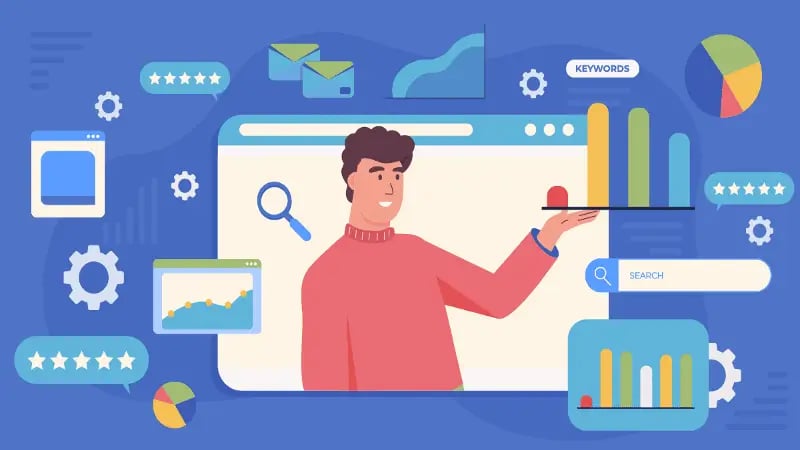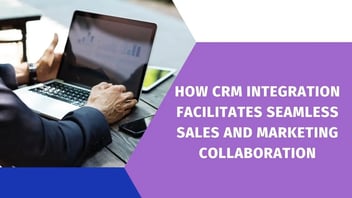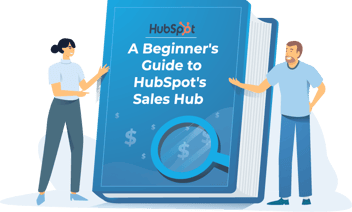A Sign of Things to Come: SaaS in 2026
SaaS trends don't just pop up out of nowhere; they're shaped by several factors that influence how people and businesses view SaaS companies. With the ever-increasing rate of innovation, there's no room for stagnation or resting on their laurels. Instead, SaaS companies need to be at the forefront of change and rely on the latest cutting-edge tools and concepts to thrive.
To understand where SaaS needs to go, it's best to look at what's been happening this year.

The “as-a-Service” Model
First, it's always helpful to understand and review the genesis behind a revolutionary concept to understand its future. As one of the trends to watch, Software as a Service (SaaS) emerged in the early 2000s. However, its roots can be traced back to earlier developments in computing and software delivery models, emerging just around the time the internet found its genesis. Key milestones in the emergence of the SaaS we all know and utilize today include:
-
Time-Sharing Systems - 1960s-1970s: The origins of SaaS can be seen in the development of time-sharing systems, which allowed multiple users to access a single computer simultaneously. This laid the groundwork for accessing software and computing resources remotely.
-
Application Service Providers (ASPs) - 1990s: ASPs, such as Yahoo and SAP, began offering hosted software solutions to businesses by hosting software applications on their own servers and providing access to them over the internet. While this was an early form of SaaS, it was not as widespread or mature as modern SaaS offerings.
-
Salesforce and SaaS - Early 2000s: The term "Software as a Service" (SaaS) gained popularity as a concept, and companies like Salesforce, founded in 1999, played a significant role in popularizing the model. Salesforce offered Customer Relationship Management (CRM) software as a service over the Internet, and their success helped establish SaaS as a viable software delivery model.
-
SaaS, IaaS, & PaaS - Mid-2000s: As SaaS adoption grew rapidly via a wide range of software applications as cloud-based services, it spawned new models of "as a service" in the technology and IT space. Other cloud computing models, Infrastructure as a Service (IaaS) and Platform as a Service (PaaS), also emerged to offer business solutions.
-
Everything as a Service - 2010s and Beyond: SaaS has continued to evolve and expand into various industries and applications, with many providers moving from perpetual/term license models to subscriptions. Today, not only have SaaS solutions become ubiquitous for a wide range of business and productivity functions, but it's also now found in industry-specific tools like healthcare management systems and financial software.
While the journey and growth that SaaS has seen within the past 70 years, the trajectory and potential of this concept are nowhere near realized yet.
Forces Shaping the Future of Service
1. Customer Demands
As the SaaS world matures, customers have become choosier. Today, SaaS users want personalized experiences, flexible pricing, and on-the-fly services. To keep customers happy, and maintain a customer-centric marketing focus, top SaaS companies are bringing in experts to improve user experiences, gather feedback, and roll out new features based on that feedback.
Customers want on-demand environments that are self-service; dependable, yet elastic enough to scale as they scale; available 24/7, anywhere in the world. It must be available through multiple channels and operating systems, easy to use, but secure.
This puts SaaS providers in a world of contradiction, according to KPMG. There's a struggle between personalization and offering essential features while maintaining their margin, remaining competitive, and ensuring they serve their customer base.
This has led to the evolution of SaaS into something closer to XaaS; Everything as a service. Everything is negotiable. Your usage models can be a subscription, consumption-based, or marketplace-based model, or even a freemium version. Customers pick what they want, when they want it, how they want it, and how they want to pay for it.
It's not just about software anymore; it's about creating a unique digital product with a personal touch.
2. The Competitive Landscape
With giants like Shopify, Salesforce, and Adobe dominating a big chunk of the market (estimated to hit $307 billion by 2026), there is an uphill battle for new SaaS businesses. Specifically, new entries into the market are facing category saturation; CRM, and procurement apps, specifically. But there is still room for niche products and specialized SaaS and XaaS if companies are willing to think outside the box.
Some areas with growth potential include databases, artificial intelligence, chatbots, and content management. These are less crowded, and we're at the early stages of seeing the final outcome. Another differentiating tactic is Micro-SaaS, a super-specialized SaaS, packaged as an API with specific tools. For example, KPMG suggests an API that allows customers to enrich the data of their users and customers rather than relying on a generic "contact enrichment tool” typically packaged in CRMs.
Other potential ideas that will grow more prevalent in 2024 are industry-and-vertical-specific SaaS products (think HR, medical tools, scientific and academia, or Web3/Blockchain applications). The applications can include secure online ID passports, monitoring animal migratory patterns, or an ATS (Applicant Tracking Service) specifically for freelance tech writers with blockchain experience.
Finally, there is a growing trend of competitors collaborating to deliver hybrid "as-a-service" models, sharing the risk and reward, for example, integrations between Slack and ClickUp to supercharge collaboration.
These micro-solutions can complement existing as-a-service products, making them even more helpful.
3. Changing Regulations
Dealing with a patchwork of compliance rules and data security standards can be a headache for SaaS providers operating locally and globally. The increasing frequency and severity of cyber-attacks and concerns over data privacy have created a patchwork of regulations and compliance requirements that make it difficult for a SaaS provider to get a handle on it all. From familiar names like HIPAA and GDPR to new entrants such as the Abu Dhabi Global Market (ADGM) to the Sherman Act in the US to new AI-related regulations, security, ethical, and data governance audits have become more of a legal requirement than a choice.
The average customer, however, doesn't even venture deep enough into the documentation and T&Cs to explore how compliant their provider is; they just want to know that their data is safe. Hence, SaaS providers need to meet their clients' security requirements even before the legal audits come into play and clarify that fact. Considering that Uber, Cisco, and Mariott have had cloud data breaches in the past year, it’s an uphill task. Every new level of security offers a potential challenge to bad actors and cybercriminals.
Clients want a clear data policy, records of IT security checks, and other safeguards. Whether this is using AI-assisted cybersecurity, for example, or “compliance-as-a-code,” where companies can cater to regional regulations while enforcing said regulatory and internal compliance by ensuring privacy by design.
Without a good grasp of regulations and data security, providers risk losing their footing in this complex landscape.
4. Tech Advancements
Companies are itching to push their digital transformation and experiment with cutting-edge ideas such as generative AI, edge computing, Web3/Blockchain, and IoT. SaaS models make these technologies easily accessible, convincing businesses to opt for ready-made solutions over building everything from scratch. Relying on APIs and low-code/no-code tools, companies can integrate new tools into existing products and offer them à la carte style. But there's a catch.
To offer these tech advancements as options, SaaS companies need to be nimble in their product design, development, and support. However, cybersecurity and code barriers keep them from offering seamless and customizable experiences on a democratized platform.
According to the Cloud Security Alliance, nearly 90% of SaaS businesses they've surveyed are getting on board with the approach that accentuates security and efficiency in the product development pipeline for fast releases. But in many cases, efficiency and increased cyber security aren't compatible. It's either released fast or released securely, and the adoption of AI isn't as helpful as it seems.
The integration of AI is meant to be the savior of DevSecOps, and at first glance, it looks promising. For example, Meta has introduced AI-generated Ads for their platforms, offering a speedy turnaround for small budgets and SMBs. Utilizing AI for customer segmentation and targeting, as Hubspot is doing, allows their customers to extract meaningful insights. But there is a catch: AI bias. Artificial intelligence is just that: artificial. It could be poor algorithm design, bias in sample selection and design, or impartial data that skews the perception of the AI.
Therefore, moving into 2024, SaaS providers who are utilizing AI are looking toward two methodologies:
-
Bias minimization via consequence scanning with a key focus on AI - programming the AI to consider intended and unintended consequences, focusing on positive consequences, and flagging mitigating negative ones.
-
Developer training - AI bias can be caused by human prejudice (either unconscious or not) during algorithm development and programming/training. Hence, developers are vetted and trained to recognize their biases and beliefs before getting to the keyboard.
5. Economic Factors and Investor Expectations
There should be no surprise regarding market factors and money as the key driver behind SaaS development and innovation. Whether it’s a SaaS company born natively in the cloud or transitioning to it, economic uncertainties and operating challenges are to be expected. During good times, companies might hike prices due to higher demand and stability to offer more long-term value, rewards, and incentives. But when belts need tightening during economic hiccups, SaaS companies face challenges in acquiring and keeping customers and satisfying investors.
Since venture capital funding took a hit in 2023, it's made it more challenging for SaaS startups to grab investors' attention.
So, to keep the revenue and interest flowing in 2024, SaaS providers should clearly define what they offer and what value comes with their solutions, including related services such as post-contract customer support or any support for on-premise or on-device software training, especially within a hybrid model. Or perhaps shifting their models to asset-light subscriptions that can fuel growth and offer better financial performance with lower set-up costs, and utilizing third-party managed service providers (MSPs) to move away from physical asset ownership, can make a SaaS/XaaS thrive.. This will offer variable cost structures, agility, and shift resources so the original SaaS company can focus on its core products, capabilities, and market segmentation without compromising service.
Winning the SaaS Landscape
Next year, new (and existing) businesses will need to use advanced analytics to predict customer behavior and identify opportunities for upselling and cross-selling. Leading players in the game are also moving quickly, launching new ventures faster than their rivals, so having tech know-how and a skilled IT team is crucial for growth.
Hence, creating and investing in a SaaS product with a strong, well-rounded development team and leadership will be the key to winning the SaaS landscape in 2024.
This content is also available in:
- German: Ein Zeichen der Zukunft: SaaS im Jahr 2026
- Spanish: Una señal de lo que está por venir: SaaS en 2026
- French: Un signe avant-coureur : SaaS en 2026
- Italian: Un segno delle cose a venire: il SaaS nel 2026
- Romanian: Un semn al lucrurilor viitoare: SaaS în 2026
- Chinese: 未来的征兆:2026 年的 SaaS

Opinions expressed in this article are those of the guest author. Aspiration Marketing neither confirms nor disputes any of the conclusions presented.








Leave a Comment